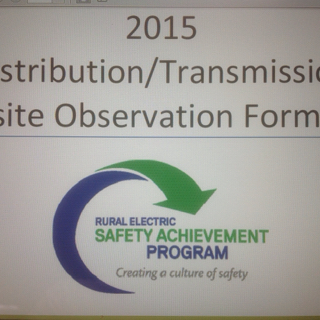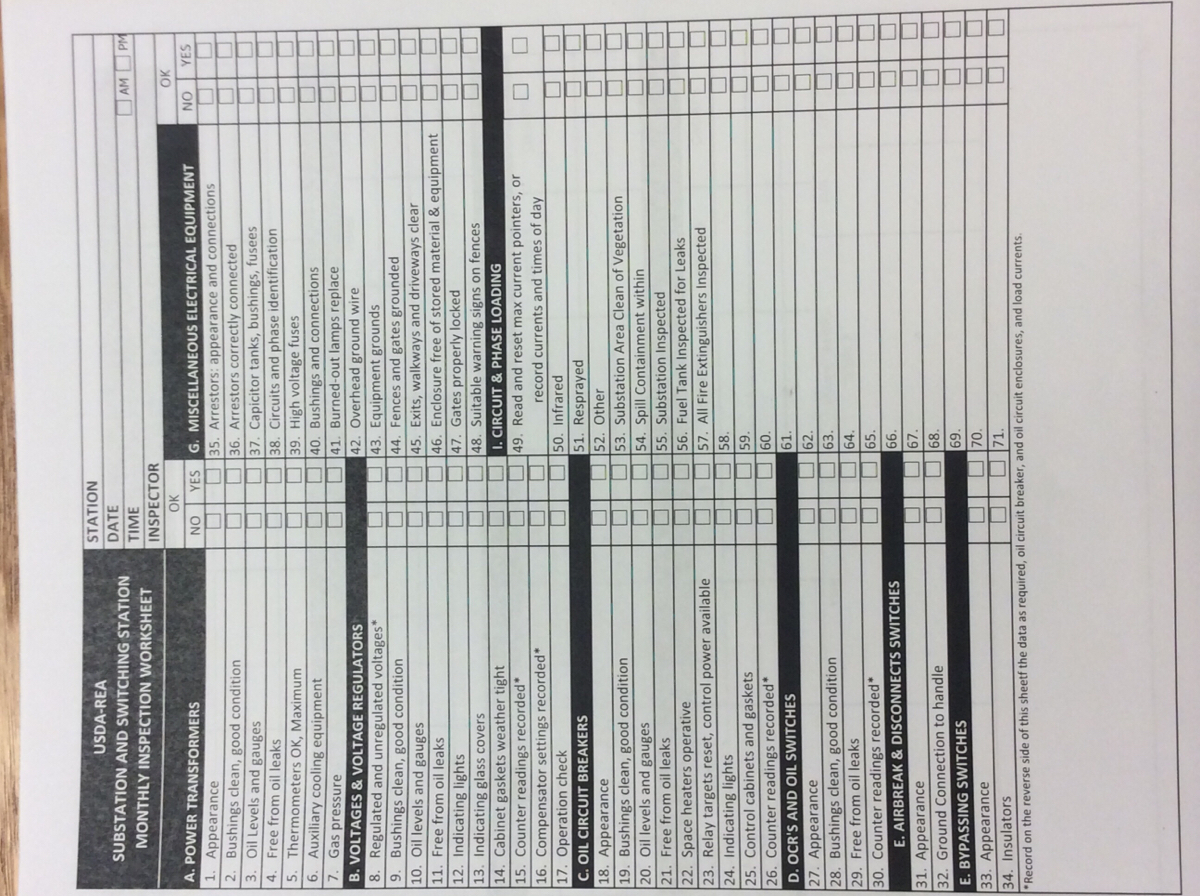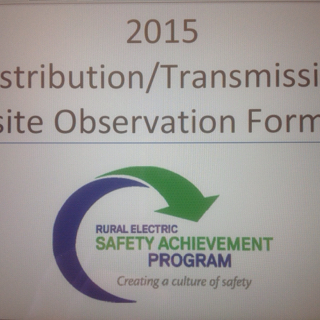Title Page
-
Cooperative Name
-
Location
-
- Main Facility
- Outpost
-
Conducted on
-
Prepared by
Section 5: Environmental/Hazardous Materials
-
5.1 Hazardous substances or waste are managed per federal and state EPA regulations including reporting, storage, transportation and disposal.<br><br>Criteria:<br>* Hazardous substances identified under EPA regulations are managed in such a way as to ensure that all required reporting and recording paper work is completed, and storage areas, cabinets and rooms are constructed and maintained appropriately.<br>* Hazardous substances and/or waste are categorized as a specified listed waste by EPA or for its characteristics such as ignitability, corrosiveness, reactivity or toxicity. Some examples are gasoline, oil, mercury in bulbs, lead and acid in batteries, herbicides, PCB's, solvents etc.<br>* Transportation of substances is performed in a way that they meet all applicable federal and state DOT requirements.<br>* All disposal requirements including manifests, transports, labeling and tracking are followed per federal and state EPA requirements.<br>* RESAP recommends that co-ops seek to eliminate the generation of hazardous substances and waste as much as possible to reduce exposure to employees and mitigate the regulatory hurdles in this area.<br><br>Ref: 29 CFR 260: 49 CFR 100-185
-
5.2 Universal waste management procedures are developed and implemented per federal and state EPA regulations.<br><br>Criteria:<br>* Materials such as spent CFL's, pesticides, batteries and aerosol cans must be managed in such a way as to prevent releases of any Universal Waste into the environment.<br>* Containers must be:<br>- Closed (except when adding or removing items)<br>- Structurally sound ( adequate to prevent breakage)<br>- Compatible with the waste <br>- Lack evidence of leakage, spillage, or damage that could cause leakage under reasonably foreseeable conditions.<br>- Properly labeled or marked clearly with the "universal waste" listings.<br>- Each container must be marked or labeled with the earliest date that any universal waste in the container became a waste ( not to exceed one year from the earliest date); OR, <br>- Each individual item of universal waste (e.g., each battery, lamp or thermostat) must be labeled with the date it became a waste or was received; OR,<br>- Maintain an inventory system on-site that identifies the date each universal waste became a waste or was received.<br><br>Ref: 40 CFR 273
-
5.3 If the co-op manages hazardous substances or waste the staff should be appropriately trained in the use and handling of these substances and trained in the use and handling of these substances and certified to respond to a hazardous or special waste release per federal and state regulations.<br><br>Criteria:<br>* Staff is trained per federal and state requirements at a level they will qualify to handle substances in the course of operations at a facility.<br>* Staff meets various OSHA standards for remedial training and id refreshed annually per these standards.<br><br>Ref: 29 CFR 1910.120
-
5.4 Underground and above ground storage tanks meet current requirements for storage, monitoring and handling of fuels onsite, and safety both federal and state regulations. Fueling areas are equipped and maintained with proper safety equipment.<br><br>Criteria:<br>* Each service or fueling area has at least one fire extinguisher with a minimum 120 B:C (20 lbs) capacity rating and is located between 25' and 75' of the pump dispensers. Conspicuous and legible signs, no smoking and shut off (gasoline) motors during fueling are posted.<br>* The dispensing nozzles are equipped with approved automatic closing devices and hoses are equipped with break-away connectors.<br>* Clearly identified and easily accessible emergency shut-offs are provided within 75' of the dispensing devices. Islands and barriers are provided to protect the fuel pumps. Hoses are stored out of traffic areas. <br>* Staff identified for fueling are trained and certified as required under state and federal operator training requirements.<br><br>Ref: 40 CFR Part 112; 40 CFR Part 280/281; 29 CFR.1917; NFPA 30A; EPA Act 2005, section 1524
-
5.5 Storage, management and disposal of PCB contaminated fluids and solids are consistent with all federal and state EPA regulations.<br><br>Criteria:<br>* Facilities have developed appropriate storage and management areas that will safely handle PCB contaminated materials for future disposal.<br>* Areas should have appropriate signage notifying the presence of PCB waste. Appropriate training and certification of staff handling PCB materials must comply with OSHA and EPA criteria.<br>* Adequate containment and barriers, including diking of areas securing PCB contaminated materials and physical barriers limiting access to the PCB materials should be available. Appropriate spill kits (size and sorbent material) suitable for mitigating spills of PCB fluids should be readily available with appropriate labels.<br>* Records for PCB management should be on file at the co-op for inspection frequency, handling and disposal of all PCB materials per federal and state regulations.<br><br>Ref: 40 CFR 761; 40 CFR 263.20; 263.21; 263.22; 29 CFR 1910.120
-
5.6 Spill prevention, Control and Countermeasures (SPCC) regulations have been implemented and a plan has been developed for the facility as required by federal EPA regulations.<br><br>Criteria: <br>* An SPCC plan has been either developed by a contractor or the co-op has self certified per EPA regulations.<br>* The plan is either certified by a P.E. or developed under Tier ll requirements.<br>* The SPCC plan is current and has been update within a 5 year period.<br>* All reportable spills are handled per EPA requirements and records are maintained as required.<br>* Staff is trained annually on the plan and records of the annual training are available at the facility.<br><br>Ref: 40 CFR Part 112
-
5.7 Pesticide storage, management and use meet federal and state EPA and Department of Agriculture requirements.<br><br>Criteria:<br>* Pesticides are stored in appropriate containers with required labels<br>* Secondary contained is adequate to contain spills and management of liquids in the case of a release.<br>* Appropriate PPE is available for those handling pesticides (gloves, eye shield, splash apron and respirator if necessary).<br>*Adequate ventilation is provided in storage rooms. Plumbed eyewash is available within required distances in pesticide handling and mixing areas.<br>* Appropriate signage such as danger pesticide storage area with skull and cross bones, danger pesticide storage, are placed in appropriate locations.<br>* Pesticide training records for all staff are kept on site and are readily accessible.<br><br>Ref: 7 CFR 110, 136; 40 CFR 167
Section 5: Summary
-
5.8 The overall evaluation of the onsite field observation team for this section of the assessment is as follows:<br><br>Criteria:<br>Strong performance - Questions evaluated as exceeds or satisfies all requirements<br>* Satisfactory performance - Questions evaluated as satisfies all requirements, could be a small number evaluated as exceeds.<br>* Generally satisfactory with minor areas for improvement - Questions evaluated as satisfies all or most requirements, improvement areas are minor.<br>* Ket attentions areas for improvement - Questions evaluated as partially satisfies or fails to satisfy requirements in important improvement areas.
AIEC Safety Personnel Signature
-
Stephen Davis
-
Daren Deverman









